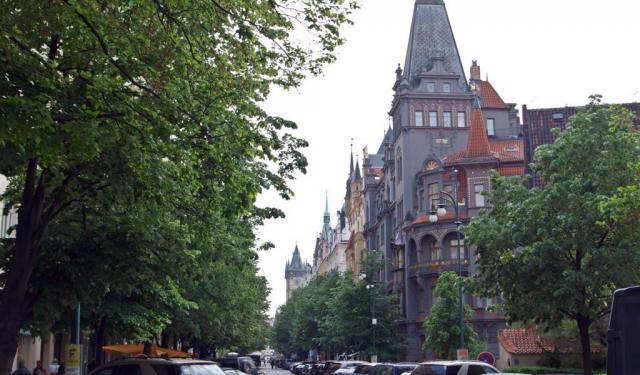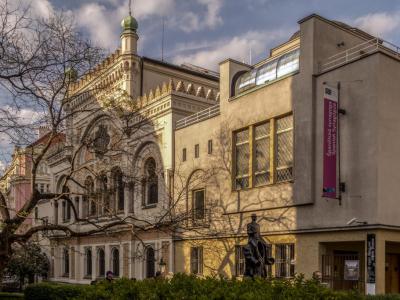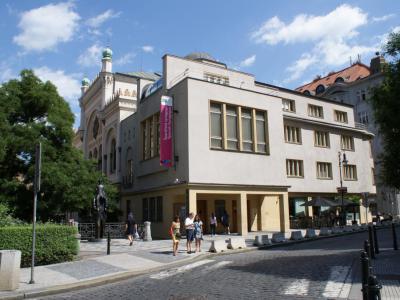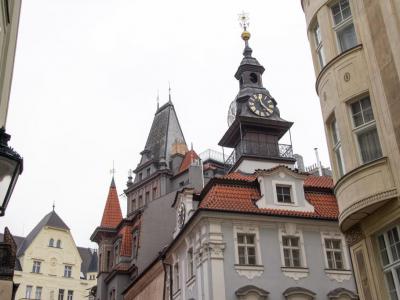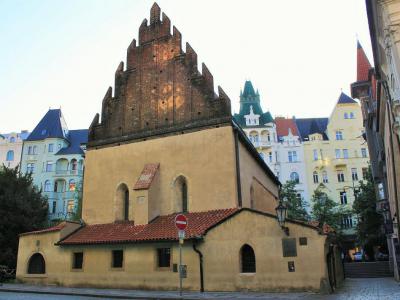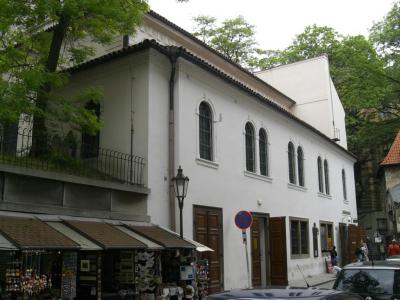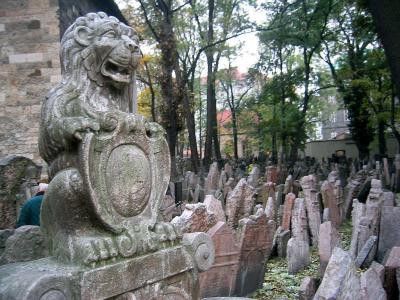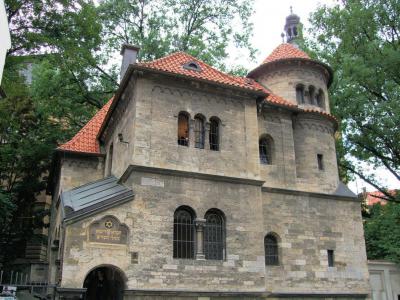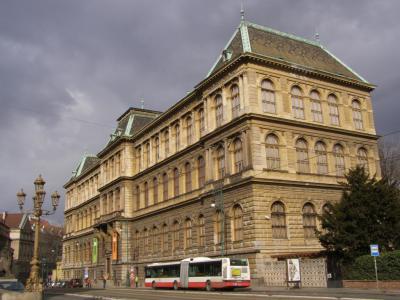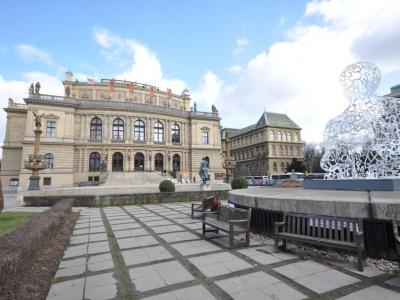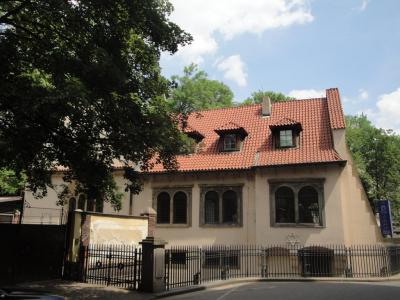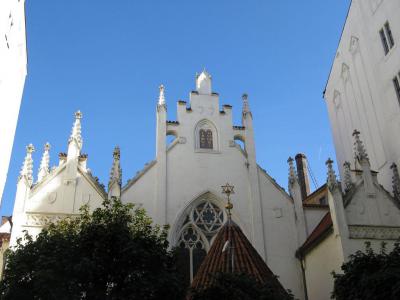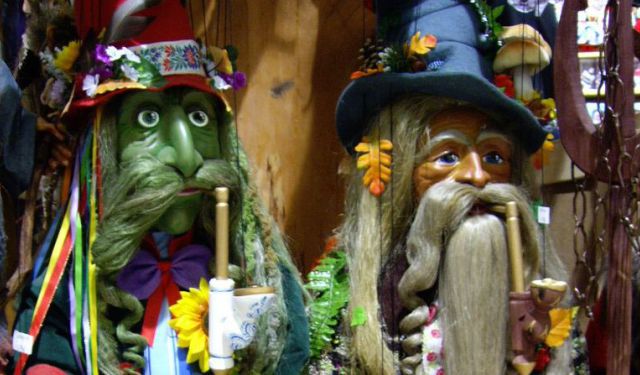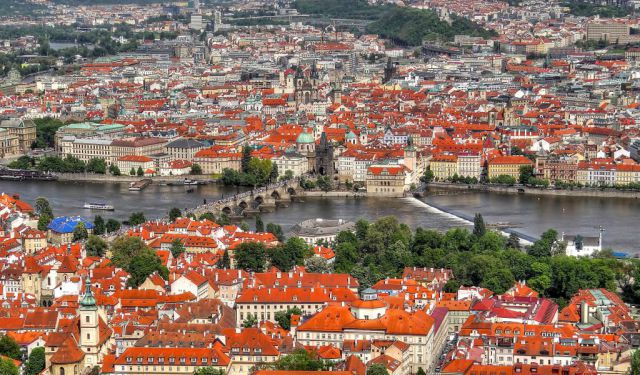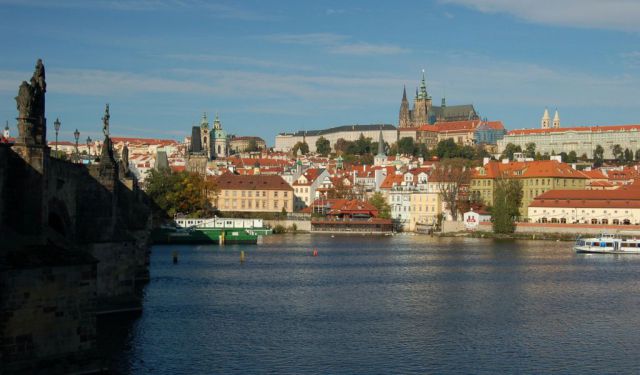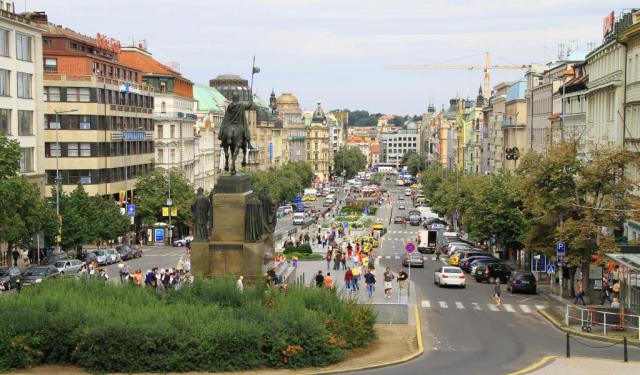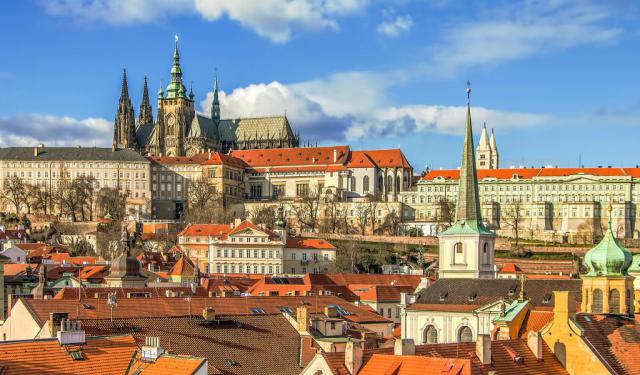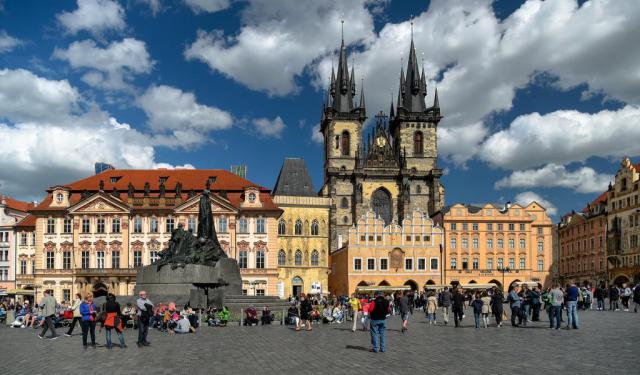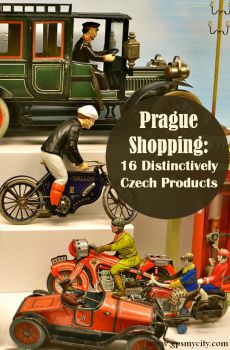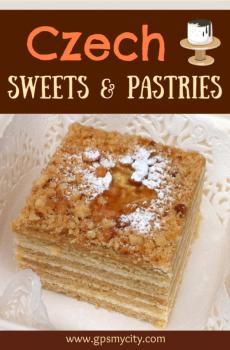Audio Guide: Jewish Quarter Walking Tour (Self Guided), Prague
The Jewish Quarter of Prague carries over a thousand years of memory etched into its streets, synagogues, and gravestones. Jewish communities began settling in this area as early as the 10th century, and although they were later forced into a walled ghetto, they cultivated a vibrant cultural and intellectual life-especially during the 16th century, a golden age shaped by the influence of Rabbi Ben Bezalel, famously linked to the legend of the Golem.
In 1781, Emperor Joseph II introduced reforms that granted the Jewish population greater civil rights, and the district was renamed Josefov in his honor. But time, politics, and urban development left their mark. During Prague’s 19th-century push toward modernization, large portions of the quarter were demolished, and only a handful of historic structures were spared. Ironically, during World War II, the Nazis preserved these sites, intending to turn them into a “Museum of an Extinct Race.” That grim plan inadvertently helped protect what remains today.
Now part of Prague’s UNESCO-listed historic center, the Jewish Quarter offers a compelling look into centuries of resilience, faith, and creativity. Some synagogues continue to serve their original purpose, while others have been thoughtfully repurposed into museums and galleries.
One of the most visually striking is the Spanish Synagogue, built in the Moorish Revival style and covered in intricate patterns. Not far away, the Jewish Museum offers a deep and moving journey into the traditions, culture, and struggles of Prague’s Jewish community over the centuries. The High Synagogue, with its graceful Renaissance facade that withstood the Great Fire of 1689, now houses exhibitions and a bookstore focused on Holocaust literature.
The Old-New Synagogue stands out not only as the oldest still-functioning synagogue in Europe but also for its stark Gothic design and the legends that surround it-most famously the tale of the Golem, a mythical guardian said to rest in the attic. Meanwhile, the Klausen Synagogue, the largest in the quarter, reveals Baroque elegance and a rich liturgical past.
And then there’s the Old Jewish Cemetery-a haunting, unforgettable landscape of tilted headstones and layered burials. One of the largest of its kind in Europe, it speaks volumes in silence.
The Pinkas Synagogue stands apart for its solemn purpose. Now a Holocaust Memorial, its walls are covered with the names of over 77,000 Czech Jews who perished during the Nazi occupation-a heartbreaking reminder of lives lost, yet not forgotten.
Together, these landmarks form a rich, emotional, and enduring narrative. For anyone curious to explore the depth of Prague’s Jewish heritage, there’s no better way than a self-guided walk-where every corner reveals another story waiting to be heard.
In 1781, Emperor Joseph II introduced reforms that granted the Jewish population greater civil rights, and the district was renamed Josefov in his honor. But time, politics, and urban development left their mark. During Prague’s 19th-century push toward modernization, large portions of the quarter were demolished, and only a handful of historic structures were spared. Ironically, during World War II, the Nazis preserved these sites, intending to turn them into a “Museum of an Extinct Race.” That grim plan inadvertently helped protect what remains today.
Now part of Prague’s UNESCO-listed historic center, the Jewish Quarter offers a compelling look into centuries of resilience, faith, and creativity. Some synagogues continue to serve their original purpose, while others have been thoughtfully repurposed into museums and galleries.
One of the most visually striking is the Spanish Synagogue, built in the Moorish Revival style and covered in intricate patterns. Not far away, the Jewish Museum offers a deep and moving journey into the traditions, culture, and struggles of Prague’s Jewish community over the centuries. The High Synagogue, with its graceful Renaissance facade that withstood the Great Fire of 1689, now houses exhibitions and a bookstore focused on Holocaust literature.
The Old-New Synagogue stands out not only as the oldest still-functioning synagogue in Europe but also for its stark Gothic design and the legends that surround it-most famously the tale of the Golem, a mythical guardian said to rest in the attic. Meanwhile, the Klausen Synagogue, the largest in the quarter, reveals Baroque elegance and a rich liturgical past.
And then there’s the Old Jewish Cemetery-a haunting, unforgettable landscape of tilted headstones and layered burials. One of the largest of its kind in Europe, it speaks volumes in silence.
The Pinkas Synagogue stands apart for its solemn purpose. Now a Holocaust Memorial, its walls are covered with the names of over 77,000 Czech Jews who perished during the Nazi occupation-a heartbreaking reminder of lives lost, yet not forgotten.
Together, these landmarks form a rich, emotional, and enduring narrative. For anyone curious to explore the depth of Prague’s Jewish heritage, there’s no better way than a self-guided walk-where every corner reveals another story waiting to be heard.
How it works: Download the app "GPSmyCity: Walks in 1K+ Cities" from Apple App Store or Google Play Store to your mobile phone or tablet. The app turns your mobile device into a personal tour guide and its built-in GPS navigation functions guide you from one tour stop to next. The app works offline, so no data plan is needed when traveling abroad.
Jewish Quarter Walking Tour Map
Guide Name: Jewish Quarter Walking Tour
Guide Location: Czech Republic » Prague (See other walking tours in Prague)
Guide Type: Self-guided Walking Tour (Sightseeing)
# of Attractions: 11
Tour Duration: 1 Hour(s)
Travel Distance: 1.1 Km or 0.7 Miles
Author: vickyc
Sight(s) Featured in This Guide:
Guide Location: Czech Republic » Prague (See other walking tours in Prague)
Guide Type: Self-guided Walking Tour (Sightseeing)
# of Attractions: 11
Tour Duration: 1 Hour(s)
Travel Distance: 1.1 Km or 0.7 Miles
Author: vickyc
Sight(s) Featured in This Guide:
- Spanish Synagogue
- Jewish Museum
- High Synagogue
- Old-New Synagogue
- Klausen Synagogue
- Old Jewish Cemetery
- Ceremonial Hall
- Museum of Decorative Arts
- Jan Palach Square
- Pinkas Synagogue - Holocaust Memorial
- Maisel Synagogue
1) Spanish Synagogue (must see)
Prague is known the world over for its architecture, and even in a city filled with Gothic spires, Baroque palaces, and Art Nouveau gems, the Spanish Synagogue manages to stand out. Situated in the Jewish Quarter, this stunning Moorish Revival landmark was completed in 1868 on the site of the city's oldest synagogue. If you're starting your exploration of the area, there’s hardly a more fitting place to begin.
From the outside, the building’s design immediately draws the eye. Its façade, divided into three sections, features a taller central portion flanked by twin domed turrets. If you’ve been to Vienna, you might notice the architectural echo of the Leopoldstadt Temple, a key inspiration. But while the exterior is impressive, the real magic begins inside.
Every inch, except the floor, is covered in elicate arabesques that twist and curl across walls and ceilings-either carved, painted, or molded with astonishing precision. The effect is mesmerizing, like being inside a jewel box. Look up and you’ll spot a richly decorated dome at the center, illuminated by a striking Magen David chandelier. The ark and bimah command attention with their elegance, and tucked at the back is a beautifully restored organ-something rarely found in synagogues.
Over the course of the 20th century, the synagogue suffered neglect under both Nazi and Communist regimes. But in the late 1990s, it was restored and reopened to the public under the care of the Jewish Museum. Today, it serves as a concert venue, while the Robert Guttmann Gallery next door hosts rotating art exhibitions of Jewish art and culture.
Interestingly, the Spanish Synagogue has never served a Sephardic or Spanish-speaking community. The origin of the name remains unclear-but one thing is certain: its beauty speaks a universal language.
From the outside, the building’s design immediately draws the eye. Its façade, divided into three sections, features a taller central portion flanked by twin domed turrets. If you’ve been to Vienna, you might notice the architectural echo of the Leopoldstadt Temple, a key inspiration. But while the exterior is impressive, the real magic begins inside.
Every inch, except the floor, is covered in elicate arabesques that twist and curl across walls and ceilings-either carved, painted, or molded with astonishing precision. The effect is mesmerizing, like being inside a jewel box. Look up and you’ll spot a richly decorated dome at the center, illuminated by a striking Magen David chandelier. The ark and bimah command attention with their elegance, and tucked at the back is a beautifully restored organ-something rarely found in synagogues.
Over the course of the 20th century, the synagogue suffered neglect under both Nazi and Communist regimes. But in the late 1990s, it was restored and reopened to the public under the care of the Jewish Museum. Today, it serves as a concert venue, while the Robert Guttmann Gallery next door hosts rotating art exhibitions of Jewish art and culture.
Interestingly, the Spanish Synagogue has never served a Sephardic or Spanish-speaking community. The origin of the name remains unclear-but one thing is certain: its beauty speaks a universal language.
2) Jewish Museum
This museum in Prague offers a journey through centuries of Jewish life, resilience, and cultural richness. Founded in 1906, it’s one of the oldest institutions of its kind in Europe, home to a remarkable collection of over 40,000 artifacts and 100,000 books. But what truly sets it apart is its unique layout: instead of being confined to a single building, it is spread across several sites within Prague’s historic Jewish Quarter, each telling a different chapter of the Jewish experience in Bohemia.
At the Maisel Synagogue, exhibitions trace the history of Jewish life in the Bohemian lands from the 10th to the 18th century. Meanwhile, the Pinkas Synagogue is one of Prague’s most haunting sites: inside, the walls are inscribed with the names of nearly 80,000 Czech Jews murdered during the Holocaust. Upstairs, drawings made by children imprisoned in the Terezín Ghetto speak louder than words, offering a glimpse into wartime innocence lost.
Just beyond the Pinkas Synagogue lies the Old Jewish Cemetery, dating back to the 1400s. With over 12,000 tightly packed gravestones rising in layers, it tells a silent yet powerful tale of centuries lived, mourned, and remembered.
The Klausen Synagogue and the neighboring Ceremonial Hall take you deeper into the daily rhythms of Jewish life-birth, coming of age, marriage, and mourning-all explored through displays of ritual objects, customs, and traditions.
A shift in tone and style awaits at the Spanish Synagogue, which houses exhibits on more recent Jewish contributions to Czech society-from the world of science and politics to literature and the arts. And don’t miss the Robert Guttmann Gallery, which offers rotating exhibitions on Jewish identity and contemporary art, drawing connections between past and present.
To take it all in at a comfortable pace, plan to visit either early in the morning or later in the day. And if you find yourself unable to absorb everything in one go, it’s well worth coming back for a second visit-there’s always more to uncover in this deeply meaningful collection of spaces.
At the Maisel Synagogue, exhibitions trace the history of Jewish life in the Bohemian lands from the 10th to the 18th century. Meanwhile, the Pinkas Synagogue is one of Prague’s most haunting sites: inside, the walls are inscribed with the names of nearly 80,000 Czech Jews murdered during the Holocaust. Upstairs, drawings made by children imprisoned in the Terezín Ghetto speak louder than words, offering a glimpse into wartime innocence lost.
Just beyond the Pinkas Synagogue lies the Old Jewish Cemetery, dating back to the 1400s. With over 12,000 tightly packed gravestones rising in layers, it tells a silent yet powerful tale of centuries lived, mourned, and remembered.
The Klausen Synagogue and the neighboring Ceremonial Hall take you deeper into the daily rhythms of Jewish life-birth, coming of age, marriage, and mourning-all explored through displays of ritual objects, customs, and traditions.
A shift in tone and style awaits at the Spanish Synagogue, which houses exhibits on more recent Jewish contributions to Czech society-from the world of science and politics to literature and the arts. And don’t miss the Robert Guttmann Gallery, which offers rotating exhibitions on Jewish identity and contemporary art, drawing connections between past and present.
To take it all in at a comfortable pace, plan to visit either early in the morning or later in the day. And if you find yourself unable to absorb everything in one go, it’s well worth coming back for a second visit-there’s always more to uncover in this deeply meaningful collection of spaces.
3) High Synagogue
A refined example of Renaissance architecture in the heart of the Jewish Quarter, the High Synagogue was funded by one of the wealthiest figures in 16th-century Prague-philanthropist Mordechai Maisel. Completed in 1568, it was strategically built next to the Jewish Town Hall and initially served as a venue for the council’s deliberations and the seat of the Rabbinic Court.
The name “High Synagogue” refers to the elevated location of the main prayer hall, which was constructed on the upper floor, giving it both symbolic and practical prominence. Though the building suffered considerable damage during the Great Fire of 1689, restoration efforts were swift and thorough. One of the original features that survived is the ribbed vaulted ceiling, with its striking eight-pointed star motif-a detail that continues to catch the eye today. Later, in 1883, the structure was renovated again, lending it the more understated exterior we see now.
During the Nazi occupation and the Communist era, the synagogue functioned as an exhibition space for the Jewish Museum, showcasing, Torah textiles, ceremonial silverwork, and rare Hebrew manuscripts. After the Velvet Revolution, a bookshop was opened on the premises, focusing on Holocaust literature and Jewish studies.
Since 1997, the High Synagogue has once again been consecrated as a place of worship. Although not open to casual visitors, those who attend services or gain access can view beautifully preserved Torah scrolls and elaborately embroidered mantles-objects that speak not only of ritual, but of continuity across generations.
The name “High Synagogue” refers to the elevated location of the main prayer hall, which was constructed on the upper floor, giving it both symbolic and practical prominence. Though the building suffered considerable damage during the Great Fire of 1689, restoration efforts were swift and thorough. One of the original features that survived is the ribbed vaulted ceiling, with its striking eight-pointed star motif-a detail that continues to catch the eye today. Later, in 1883, the structure was renovated again, lending it the more understated exterior we see now.
During the Nazi occupation and the Communist era, the synagogue functioned as an exhibition space for the Jewish Museum, showcasing, Torah textiles, ceremonial silverwork, and rare Hebrew manuscripts. After the Velvet Revolution, a bookshop was opened on the premises, focusing on Holocaust literature and Jewish studies.
Since 1997, the High Synagogue has once again been consecrated as a place of worship. Although not open to casual visitors, those who attend services or gain access can view beautifully preserved Torah scrolls and elaborately embroidered mantles-objects that speak not only of ritual, but of continuity across generations.
4) Old-New Synagogue
The Old-New Synagogue stands as one the most historically significant landmarks-Europe’s oldest synagogue still in regular use. When first completed in the 13th century, it was known simply as the “New” or “Great” Synagogue. The slightly ironic name “Old-New” came later, after additional synagogues were built nearby during the 16th century.
Unlike the richly adorned buildings that surround it, this synagogue embraces a striking simplicity. The high vaulted ceilings, Gothic arched windows, and unembellished ironwork create a solemn atmosphere that feels both ancient and enduring. One of the most distinctive features is the rare twin-nave layout, thought to be inspired by Christian monasteries of the same era-an architectural crossover not often seen in Jewish houses of worship.
Beyond the stone and mortar lies legend. According to local lore, the attic once housed a clay guardian-the Golem-brought to life by Rabbi Judah Löw in the late 1500s. Created to protect the Jewish community from harm, the Golem was said to obey its creator faithfully-until, like a tale out of folklore, it began to spiral out of control. To prevent further danger, the Rabbi deactivated the creature and sealed it away in the attic, where it supposedly still rests. The area remains closed to visitors, ensuring their “safety”. Other stories claim that the synagogue's survival through centuries of conflict and disaster is thanks to a divine presence-angelic wings that turned into doves to shield the building from harm.
Although the Old-New Synagogue operates independently of the Jewish Museum, visitors can still explore it using the Prague Jewish Town ticket, which provides access to several nearby historic sites. Advance booking is recommended, and tickets are available online for those hoping to secure a guaranteed visit.
Unlike the richly adorned buildings that surround it, this synagogue embraces a striking simplicity. The high vaulted ceilings, Gothic arched windows, and unembellished ironwork create a solemn atmosphere that feels both ancient and enduring. One of the most distinctive features is the rare twin-nave layout, thought to be inspired by Christian monasteries of the same era-an architectural crossover not often seen in Jewish houses of worship.
Beyond the stone and mortar lies legend. According to local lore, the attic once housed a clay guardian-the Golem-brought to life by Rabbi Judah Löw in the late 1500s. Created to protect the Jewish community from harm, the Golem was said to obey its creator faithfully-until, like a tale out of folklore, it began to spiral out of control. To prevent further danger, the Rabbi deactivated the creature and sealed it away in the attic, where it supposedly still rests. The area remains closed to visitors, ensuring their “safety”. Other stories claim that the synagogue's survival through centuries of conflict and disaster is thanks to a divine presence-angelic wings that turned into doves to shield the building from harm.
Although the Old-New Synagogue operates independently of the Jewish Museum, visitors can still explore it using the Prague Jewish Town ticket, which provides access to several nearby historic sites. Advance booking is recommended, and tickets are available online for those hoping to secure a guaranteed visit.
5) Klausen Synagogue
Conveniently located right at the entrance to the Old Jewish Cemetery, the Klausen Synagogue is the largest in Prague’s historic Jewish Quarter. Built at the end of the 17th century, its foundations rest on the site of three earlier structures-a small synagogue, a school, and a ritual bath-all consumed by the devastating fire that swept through the ghetto in 1689. The new building, shaped by early Baroque design, quickly became a central part of the community’s spiritual and social life.
During the Second World War, the synagogue was seized by the Nazis and used as a storage space, a grim chapter that led to the loss of much of its interior detail. In the years following the war, it became part of the Jewish Museum in Prague and has since offered visitors a meaningful window into Jewish life and ritual. The permanent exhibitions focused on everyday customs and the major Jewish holidays have long been a favorite among those interested in the cultural fabric of Czech Jewry.
Inside, visitors would normally find a spacious nave beneath a barrel-vaulted ceiling, adorned with Baroque stucco work-acanthus leaves, cascading fruit garlands, and intricate detailing that adds a sense of movement and warmth. Sunlight pours through tall arched windows, casting a golden glow across the space. One of the most cherished elements is the Torah Ark, carved from wood in 1696. Positioned at the front of the hall, it showcases the artistry and devotion that defined the period.
As of July 2024, the Klausen Synagogue is temporarily closed for major renovations, with a planned reopening set for 2028. When it reopens, a new core exhibition focused on Jewish customs and daily practices will take center stage, continuing the synagogue’s role as a bridge between past and present. For the latest updates and announcements, be sure to check the official website of the Jewish Museum in Prague.
During the Second World War, the synagogue was seized by the Nazis and used as a storage space, a grim chapter that led to the loss of much of its interior detail. In the years following the war, it became part of the Jewish Museum in Prague and has since offered visitors a meaningful window into Jewish life and ritual. The permanent exhibitions focused on everyday customs and the major Jewish holidays have long been a favorite among those interested in the cultural fabric of Czech Jewry.
Inside, visitors would normally find a spacious nave beneath a barrel-vaulted ceiling, adorned with Baroque stucco work-acanthus leaves, cascading fruit garlands, and intricate detailing that adds a sense of movement and warmth. Sunlight pours through tall arched windows, casting a golden glow across the space. One of the most cherished elements is the Torah Ark, carved from wood in 1696. Positioned at the front of the hall, it showcases the artistry and devotion that defined the period.
As of July 2024, the Klausen Synagogue is temporarily closed for major renovations, with a planned reopening set for 2028. When it reopens, a new core exhibition focused on Jewish customs and daily practices will take center stage, continuing the synagogue’s role as a bridge between past and present. For the latest updates and announcements, be sure to check the official website of the Jewish Museum in Prague.
6) Old Jewish Cemetery
The Old Jewish Cemetery in Prague is one of the most hauntingly beautiful sites in the city-and one of the largest of its kind in Europe. For centuries, it served as the only permitted burial ground for the Jewish community, with graves dating from the early 15th century all the way to 1787. Because space within the walled ghetto was so limited, burials were layered-sometimes up to twelve deep-resulting in a sea of tombstones tilted, clustered, and rising unevenly from the earth. The 12,000 visible headstones you see today represent just a portion of those actually buried here.
In the beginning, gravestones were modest-simple markers for simple times. Over the years, however, they grew increasingly ornate. By the 17th century, headstones featured decorative flourishes like pilasters, volutes, and even carved false doorways, symbolizing the passage from one world to the next. Inscriptions are written in Hebrew and often include the deceased's name, along with the date of death or burial. From the Renaissance onward, brief eulogies were expanded to include poetic praise, while engraved symbols began to appear-clues to the person’s character, name, or profession. A pair of hands might represent a descendant of priests; a pair of scissors could point to a tailor.
Among the cemetery’s most notable graves is that of Avigdor Kara, a 15th-century poet whose original headstone now resides in the Maisel Synagogue. His is the oldest marked burial in the cemetery. Another revered figure laid to rest here is Rabbi Judah Loew ben Bezalel-better known as Rabbi Löw-the brilliant scholar and mystic behind the legend of the Golem. Even today, visitors leave tiny scraps of paper bearing prayers and wishes tucked into the cracks of his tombstone, hoping for a little intervention from the spiritual world.
In the beginning, gravestones were modest-simple markers for simple times. Over the years, however, they grew increasingly ornate. By the 17th century, headstones featured decorative flourishes like pilasters, volutes, and even carved false doorways, symbolizing the passage from one world to the next. Inscriptions are written in Hebrew and often include the deceased's name, along with the date of death or burial. From the Renaissance onward, brief eulogies were expanded to include poetic praise, while engraved symbols began to appear-clues to the person’s character, name, or profession. A pair of hands might represent a descendant of priests; a pair of scissors could point to a tailor.
Among the cemetery’s most notable graves is that of Avigdor Kara, a 15th-century poet whose original headstone now resides in the Maisel Synagogue. His is the oldest marked burial in the cemetery. Another revered figure laid to rest here is Rabbi Judah Loew ben Bezalel-better known as Rabbi Löw-the brilliant scholar and mystic behind the legend of the Golem. Even today, visitors leave tiny scraps of paper bearing prayers and wishes tucked into the cracks of his tombstone, hoping for a little intervention from the spiritual world.
7) Ceremonial Hall
As you step out of the Old Jewish Cemetery and glance to your left, you’ll notice a building that looks like a small fortress or perhaps a nobleman’s residence from another era. That’s the Ceremonial Hall, and while it may not come with a dramatic backstory, its purpose was deeply rooted in the rituals of Jewish life and death.
Built in the early 20th century in a bold Neo-Romanesque style, the hall was commissioned by the Prague Jewish Burial Society. This was no ordinary society-it was made up of respected members entrusted with the sacred task of caring for the dead. Inside, the building was arranged with purpose: the basement was used as a morgue, the ground floor held a space for ritual purification, and the upper floor served as a meeting hall-where the Burial Society conducted business, held ceremonies, and even hosted annual banquets.
Until its closure for renovations in July 2024, the Ceremonial Hall was home to a fascinating exhibit titled “Jewish Customs and Traditions”. The display explored the full spectrum of Jewish life-from birth to death-with special focus on religious rites and communal practices. One of the highlights was an evocative 18th-century painting series illustrating burial customs, along with ceremonial objects and archival materials related to the Burial Society’s history.
The hall is currently undergoing extensive restoration, with plans to reopen by the end of 2026. When it returns, visitors can look forward to an updated core exhibition, once again dedicated to the rituals and traditions that have shaped Jewish identity for centuries. For the latest announcements, keep an eye on the official website of the Jewish Museum in Prague.
Built in the early 20th century in a bold Neo-Romanesque style, the hall was commissioned by the Prague Jewish Burial Society. This was no ordinary society-it was made up of respected members entrusted with the sacred task of caring for the dead. Inside, the building was arranged with purpose: the basement was used as a morgue, the ground floor held a space for ritual purification, and the upper floor served as a meeting hall-where the Burial Society conducted business, held ceremonies, and even hosted annual banquets.
Until its closure for renovations in July 2024, the Ceremonial Hall was home to a fascinating exhibit titled “Jewish Customs and Traditions”. The display explored the full spectrum of Jewish life-from birth to death-with special focus on religious rites and communal practices. One of the highlights was an evocative 18th-century painting series illustrating burial customs, along with ceremonial objects and archival materials related to the Burial Society’s history.
The hall is currently undergoing extensive restoration, with plans to reopen by the end of 2026. When it returns, visitors can look forward to an updated core exhibition, once again dedicated to the rituals and traditions that have shaped Jewish identity for centuries. For the latest announcements, keep an eye on the official website of the Jewish Museum in Prague.
8) Museum of Decorative Arts
A cornerstone of Prague’s cultural landscape, the Museum of Decorative Arts has been celebrating craftsmanship and design since its founding in 1885. Housed in a stately Neo-Renaissance building, it is ideally situated near the Old Town Square and the Vltava River. The structure itself is a visual feast-graced with frescoes, stucco detailing, stained glass, and ornate staircases, it reflects the very artistry and elegance championed within its walls.
The collection here is quite diverse, comprising everything from delicate glass and fine porcelain to intricate textiles, jewelry, clocks, toys, furniture, and graphic design. The scope stretches from Late Antiquity all the way to contemporary design, with a strong emphasis on European decorative arts and Bohemian craftsmanship.
One of the standout attractions is the permanent exhibition, “Art, Life. Art for Life”. This dynamic display weaves together centuries of European applied arts, tracing how everyday objects-such as tables, teapots, or tapestries-have reflected changing tastes, technologies, and social values. Each object tells a story-not just of aesthetics, but of how beauty and functionality have evolved side by side over the centuries.
Beyond the galleries, visitors may also find the Czech Republic’s largest public library focused on art, design, and architecture. With over 172,000 volumes, it’s a treasure trove for students, scholars, and anyone with a passion for visual culture.
The museum also operates several branches, including the Josef Sudek Gallery, which honors the renowned Czech photographer with rotating exhibitions. At the House at the Black Madonna, you can dive into Czech Cubism through striking furniture, glass, and ceramics. And at the Chateau in Kamenice, guests are treated to charming displays of historical toys, furniture design, and finely crafted wrought iron.
The collection here is quite diverse, comprising everything from delicate glass and fine porcelain to intricate textiles, jewelry, clocks, toys, furniture, and graphic design. The scope stretches from Late Antiquity all the way to contemporary design, with a strong emphasis on European decorative arts and Bohemian craftsmanship.
One of the standout attractions is the permanent exhibition, “Art, Life. Art for Life”. This dynamic display weaves together centuries of European applied arts, tracing how everyday objects-such as tables, teapots, or tapestries-have reflected changing tastes, technologies, and social values. Each object tells a story-not just of aesthetics, but of how beauty and functionality have evolved side by side over the centuries.
Beyond the galleries, visitors may also find the Czech Republic’s largest public library focused on art, design, and architecture. With over 172,000 volumes, it’s a treasure trove for students, scholars, and anyone with a passion for visual culture.
The museum also operates several branches, including the Josef Sudek Gallery, which honors the renowned Czech photographer with rotating exhibitions. At the House at the Black Madonna, you can dive into Czech Cubism through striking furniture, glass, and ceramics. And at the Chateau in Kamenice, guests are treated to charming displays of historical toys, furniture design, and finely crafted wrought iron.
9) Jan Palach Square
Among Prague’s many historic places, this one stands out not for its age, but for the emotional weight it carries. Originally named Square of the Red Army, it honored Soviet soldiers who died during the liberation of Prague in 1945. But in 1970, something shifted. The square was informally renamed after Jan Palach, a philosophy student who, in an act of protest against the Soviet-led invasion of Czechoslovakia, took his own life by self-immolation. His action resonated deeply with a nation under pressure, becoming a symbol of defiance. After years of quiet resistance, the name was officially adopted in 1989, just as Communist rule was coming to an end.
The square itself is beautifully situated, with the western side opening up to sweeping views of the Vltava River, Charles Bridge, and the silhouette of Prague Castle. The Mánes Bridge links the area to the Lesser Town, offering a picturesque crossing point. Look to the north, and you’ll see the stately Rudolfinum-a Neo-Renaissance concert hall and gallery that hosts the Czech Philharmonic. To the south is the Academy of Arts, Architecture, and Design, a hub of creativity and academic tradition. On the eastern edge stands the Faculty of Arts, part of Charles University, where many of the city’s intellectual movements took shape.
The space is also dotted with tributes to Czech cultural giants. In front of the Rudolfinum, you’ll find a statue of composer Antonín Dvořák, while near the river, another sculpture honors Josef Mánes, the painter behind the beloved calendar medallions on the Astronomical Clock. And not far from the Faculty of Arts, the memory of Jan Palach is honored through two striking sculptures: “The House of the Suicide” and “The House of the Mother of the Suicide”. Designed by American architect John Hejduk, these stark, solemn, and powerful structures, installed in 2016, capture the depth of a personal loss that became a national wake-up call.
The square itself is beautifully situated, with the western side opening up to sweeping views of the Vltava River, Charles Bridge, and the silhouette of Prague Castle. The Mánes Bridge links the area to the Lesser Town, offering a picturesque crossing point. Look to the north, and you’ll see the stately Rudolfinum-a Neo-Renaissance concert hall and gallery that hosts the Czech Philharmonic. To the south is the Academy of Arts, Architecture, and Design, a hub of creativity and academic tradition. On the eastern edge stands the Faculty of Arts, part of Charles University, where many of the city’s intellectual movements took shape.
The space is also dotted with tributes to Czech cultural giants. In front of the Rudolfinum, you’ll find a statue of composer Antonín Dvořák, while near the river, another sculpture honors Josef Mánes, the painter behind the beloved calendar medallions on the Astronomical Clock. And not far from the Faculty of Arts, the memory of Jan Palach is honored through two striking sculptures: “The House of the Suicide” and “The House of the Mother of the Suicide”. Designed by American architect John Hejduk, these stark, solemn, and powerful structures, installed in 2016, capture the depth of a personal loss that became a national wake-up call.
10) Pinkas Synagogue - Holocaust Memorial
Built in 1535, Prague’s second-oldest synagogue has borne witness to centuries of change. Today, it serves as a solemn tribute to over 77,000 Czech Jews who perished during the Holocaust. Though the building has been restored multiple times, its most profound transformation came in the 1990s, when the interior walls were carefully inscribed with the names of the victims, each one listed alongside their hometown in Bohemia or Moravia. Stepping inside feels less like entering a historic monument and more like walking into a vast, silent book of remembrance-every wall a page, every name a life once lived.
As visitors continue through the space, they enter a deeply emotional exhibit that features artwork created by children held in the Terezín ghetto during the war. These drawings were made during secret art classes led by a courageous teacher interned at the camp from 1942 to 1944. Despite the ever-present threat of deportation, she encouraged the children to express their inner worlds through art. Knowing the danger, she hid their work in two suitcases, which remarkably survived the war and today offer a rare glimpse into the lives of those young souls, many of whom would never return home.
Visitors can also witness “Faces of the Victims of the Shoah”, an evening video projection that casts photographs of Holocaust victims onto the synagogue’s exterior-clearly visible from the nearby street. The display's duration changes with the seasons, lasting up to two and a half hours during the longer winter nights.
As visitors continue through the space, they enter a deeply emotional exhibit that features artwork created by children held in the Terezín ghetto during the war. These drawings were made during secret art classes led by a courageous teacher interned at the camp from 1942 to 1944. Despite the ever-present threat of deportation, she encouraged the children to express their inner worlds through art. Knowing the danger, she hid their work in two suitcases, which remarkably survived the war and today offer a rare glimpse into the lives of those young souls, many of whom would never return home.
Visitors can also witness “Faces of the Victims of the Shoah”, an evening video projection that casts photographs of Holocaust victims onto the synagogue’s exterior-clearly visible from the nearby street. The display's duration changes with the seasons, lasting up to two and a half hours during the longer winter nights.
11) Maisel Synagogue
Like the Jewish Town Hall and the Klausen and High Synagogues, the Maisel Synagogue owes its existence to the generosity of Mordecai Maisel-a wealthy philanthropist, influential mayor of Prague’s Jewish Town, and key figure at the court of Emperor Rudolf II. Constructed in the late 16th century, it was not only one of the most splendid synagogues of its time but also the first in Prague to welcome women into its services. The original structure was built in the Renaissance style; however, the Great Fire of 1689 devastated much of the building. A Baroque redesign followed, only to be replaced in the late 19th century by the neo-Gothic façade you see today.
Inside, the synagogue now serves as a museum space dedicated to the history of Jewish life in the Czech lands, with a focus on the period leading up to the late 18th century. The whitewashed walls create a quiet, contemplative setting for the exhibition. Displayed in glass cases are finely crafted ritual objects: gold and silver Hanukkah lamps, Torah scrolls adorned with embroidered mantles, and delicately worked ceremonial items. Some pieces offer curious insights into social customs, such as the starched ruffs once worn by unmarried Jewish boys from the age of twelve.
Many of the most exquisite artifacts come from the golden age of the 16th and early 17th centuries-a time when Prague’s Jewish community flourished culturally and economically. There is a certain tragic irony, however: a large number of these items were brought to Prague during the Nazi occupation, seized from synagogues across Bohemia and Moravia with the intent of showcasing them in a planned “museum of an extinct race.”
Adding a modern layer to the experience, interactive displays allow to explore historical maps and biographies of notable figures. A highlight is the immersive video installation “Flight Over the Prague Jewish Town”, projected on a large screen and based on Antonín Langweil’s 19th-century paper model of the city-a rare bird’s-eye view into the vanished world of the former ghetto.
Inside, the synagogue now serves as a museum space dedicated to the history of Jewish life in the Czech lands, with a focus on the period leading up to the late 18th century. The whitewashed walls create a quiet, contemplative setting for the exhibition. Displayed in glass cases are finely crafted ritual objects: gold and silver Hanukkah lamps, Torah scrolls adorned with embroidered mantles, and delicately worked ceremonial items. Some pieces offer curious insights into social customs, such as the starched ruffs once worn by unmarried Jewish boys from the age of twelve.
Many of the most exquisite artifacts come from the golden age of the 16th and early 17th centuries-a time when Prague’s Jewish community flourished culturally and economically. There is a certain tragic irony, however: a large number of these items were brought to Prague during the Nazi occupation, seized from synagogues across Bohemia and Moravia with the intent of showcasing them in a planned “museum of an extinct race.”
Adding a modern layer to the experience, interactive displays allow to explore historical maps and biographies of notable figures. A highlight is the immersive video installation “Flight Over the Prague Jewish Town”, projected on a large screen and based on Antonín Langweil’s 19th-century paper model of the city-a rare bird’s-eye view into the vanished world of the former ghetto.
Walking Tours in Prague, Czech Republic
Create Your Own Walk in Prague
Creating your own self-guided walk in Prague is easy and fun. Choose the city attractions that you want to see and a walk route map will be created just for you. You can even set your hotel as the start point of the walk.
Old Town Souvenir Shopping
Strolling through the Old Town of Prague, souvenir shopping becomes a delightful adventure. Indeed, it would be a pity to leave Prague without having explored its specialty shops and bringing home something truly original and unique to the city.
One of the prime spots for such endeavors is the Municipal House, a majestic Art Nouveau building that houses various shops and boutiques. Here,... view more
Tour Duration: 1 Hour(s)
Travel Distance: 1.7 Km or 1.1 Miles
One of the prime spots for such endeavors is the Municipal House, a majestic Art Nouveau building that houses various shops and boutiques. Here,... view more
Tour Duration: 1 Hour(s)
Travel Distance: 1.7 Km or 1.1 Miles
Prague Introduction Walking Tour
Nicknamed the “City of a Hundred Spires,” Prague is a living gallery of history and architecture, home to world-class museums, eclectic galleries, numerous theaters, and a seemingly endless collection of historic landmarks.
The name Praha comes from the old Slavic word “práh”, which means “rapid”, nodding to the city's beginnings at a crossing on the Vltava River. Legend... view more
Tour Duration: 2 Hour(s)
Travel Distance: 3.2 Km or 2 Miles
The name Praha comes from the old Slavic word “práh”, which means “rapid”, nodding to the city's beginnings at a crossing on the Vltava River. Legend... view more
Tour Duration: 2 Hour(s)
Travel Distance: 3.2 Km or 2 Miles
Lesser Town Walking Tour
Malá Strana, or the “Lesser Town,” lies along the left bank of the Vltava River and remains one of Prague’s most charming and historically layered districts. In medieval times, it was primarily settled by ethnic Germans, and even as Baroque architecture reshaped the neighborhood following the devastating fire of 1541, the area held onto its Germanic roots for generations. Its location near... view more
Tour Duration: 2 Hour(s)
Travel Distance: 3.9 Km or 2.4 Miles
Tour Duration: 2 Hour(s)
Travel Distance: 3.9 Km or 2.4 Miles
New Town Walking Tour
The youngest (founded in 1348) and the largest (three times the size of the Old Town), the New Town (or Nove Mesto) of Prague is one of the five originally independent townships that today form the historic center of the Czech capital. This vibrant district offers a mix of historical charm and modern amenities and is traditionally dense with tourists.
At its heart lies Wenceslas Square, a... view more
Tour Duration: 2 Hour(s)
Travel Distance: 3.1 Km or 1.9 Miles
At its heart lies Wenceslas Square, a... view more
Tour Duration: 2 Hour(s)
Travel Distance: 3.1 Km or 1.9 Miles
Hradcany (Castle District) Walking Tour
Prague’s Castle District is a neighborhood where history feels almost tangible-an atmospheric blend of towering landmarks, quiet courtyards, and sweeping city views. At its heart sits the mighty Prague Castle, often cited as the largest castle complex in the world. Its origins stretch back to the 9th century, and over time, it has been home to Bohemian kings, Holy Roman emperors, Communist... view more
Tour Duration: 2 Hour(s)
Travel Distance: 3.0 Km or 1.9 Miles
Tour Duration: 2 Hour(s)
Travel Distance: 3.0 Km or 1.9 Miles
Old Town Walking Tour
Prague’s Old Town is a living tapestry of medieval roots and vibrant modern life, wrapped in narrow cobblestone streets and brimming with architectural treasures. Once a self-contained settlement, it was protected by a semi-circular moat and a fortified wall, both tracing the curve of the Vltava River. Although the moat is long gone, its path survives in the form of key streets-most notably Na... view more
Tour Duration: 2 Hour(s)
Travel Distance: 2.8 Km or 1.7 Miles
Tour Duration: 2 Hour(s)
Travel Distance: 2.8 Km or 1.7 Miles
Useful Travel Guides for Planning Your Trip
Prague Shopping: 15 Distinctively Czech Products to Bring Home
Previously known mainly for its beer and ice-hockey (both for a very good reason), today's Czech Republic - and, primarily, its capital city Prague - is seen among the top European tourist destinations emerged following the breakup of the Soviet Bloc. A shooting ground for some Hollywood...
Czech Sweets and Pastries
Once part of the Austro-Hungarian Empire, the Czechs have duly absorbed the dessert-making know-how of their Austrian neighbors to complement their own confectionery heritage deeply rooted in the Eastern European, Slavic tradition. The end result of such cultural blend is the abundance of pastries,...
The Most Popular Cities
/ view all
